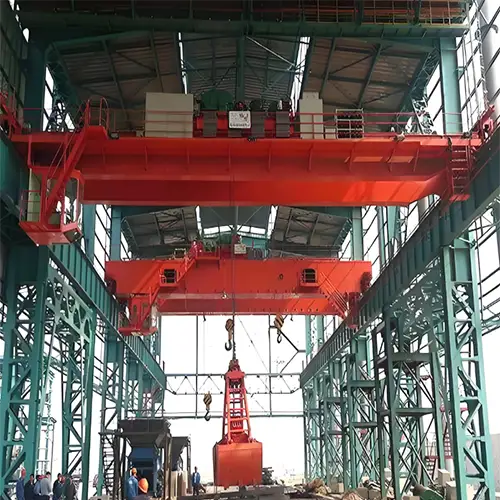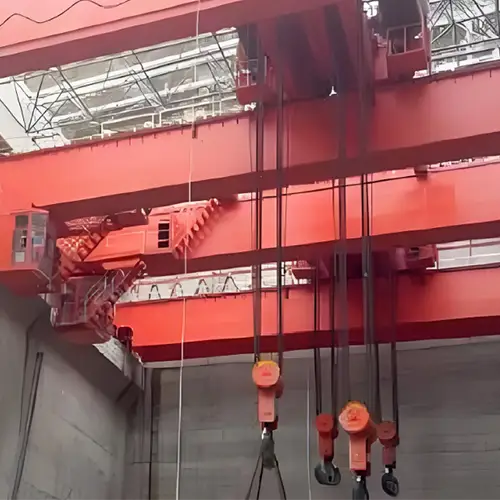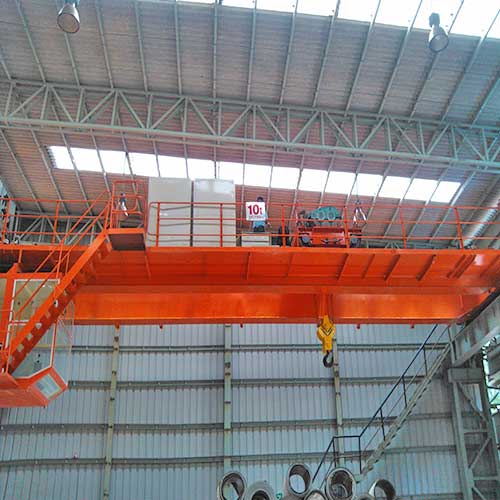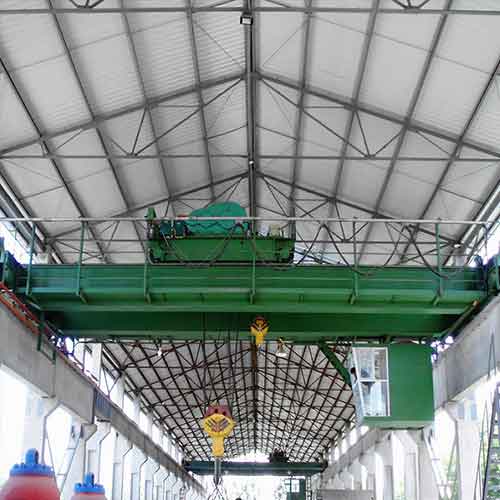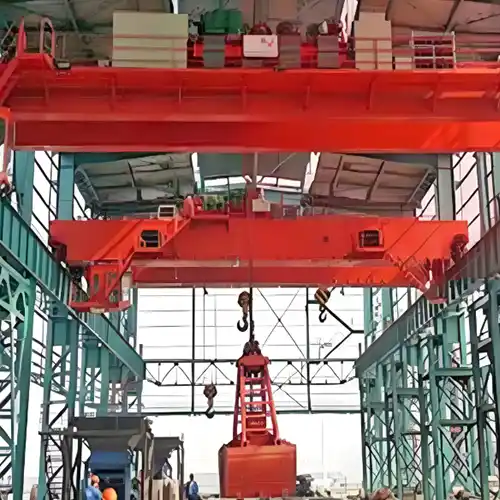Heavy Duty Overhead Cranes for Ash Handling Thermal Power Plants
Heavy duty overhead crane for Ash Handling Thermal Power Plants. 10 ton to 100 Ton overhead crane double girder design for heavy-duty material handling.
Category: General Manufacturing
Your Trusted Heavy Duty Overhead Crane Manufacturer & Supplier
Heavy Duty Overhead Cranes 10 Ton to 80 Ton for Ash Handling Thermal Power Plants
Heavy duty overhead crane for Ash Handling Thermal Power Plants. 10 ton to 80 Ton overhead crane double girder design for heavy duty material handling.
Ash handling required in Thermal Power Plants
Thermal power plants play a crucial role in generating electricity for our daily lives. They convert heat energy, primarily from burning coal or natural gas, into electrical power through steam generation. This process involves heating water to create steam, which then drives turbines connected to generators. While this method is effective for power generation, it also results in a significant byproduct: ash.
Ash management presents a considerable challenge for thermal power plants. As fuel is combusted, various types of ash are produced, including bottom ash and fly ash, each requiring different handling methods. Effective ash handling systems are vital not only for maintaining cleanliness but also for ensuring the safety and efficiency of the operation. If ash is not managed properly, it can accumulate and obstruct equipment, leading to increased downtime, higher maintenance costs, and potential safety hazards.
Moreover, poorly managed ash can result in environmental concerns, such as dust emissions and contamination of surrounding areas. Implementing efficient ash handling systems minimizes these risks, helping to comply with environmental regulations and promoting sustainability.
By streamlining the ash handling process, thermal power plants enhance their operational reliability. An efficient system reduces the need for frequent maintenance, allowing for continuous operation and ultimately saving money over time. Investing in robust ash handling solutions ensures that power plants can focus on their primary goal: delivering electricity to consumers without unnecessary interruptions.

Typical Crane System Used for Ash Handling
Overview of Overhead Crane Systems
In the field of ash handling, overhead crane systems are the go-to solution for efficiently managing heavy ash loads within thermal power plants. These cranes provide the ability to lift, transport, and place large quantities of ash with ease, significantly streamlining the handling process. Imagine a powerful crane that can move ash effortlessly—that's precisely what these overhead systems are designed to do.
Maximizing Vertical Space
One of the primary advantages of overhead cranes is their ability to maximize vertical space. Unlike ground-based systems that require extensive floor space for movement, overhead cranes operate from above, allowing for optimal use of limited areas. This is particularly beneficial in thermal power plants, where space can be tight due to various equipment and operations. With overhead cranes, you can effectively navigate crowded environments without compromising productivity.
Handling Heavy Loads
These cranes are engineered to handle heavy loads, making them ideal for managing both bottom ash and fly ash. Bottom ash, which is denser and heavier, requires robust lifting capabilities, while fly ash, being lighter but voluminous, still demands efficient handling to prevent dust and environmental contamination. Overhead cranes are equipped to manage these varying demands, ensuring that ash is moved quickly and safely.
Enhancing Workplace Safety
Using overhead cranes also enhances workplace safety. They reduce the need for manual handling, which can be risky and labor-intensive. By minimizing human intervention in lifting and transporting ash, the risk of accidents and injuries is significantly lowered. Operators can manage loads from a safe distance, and the cranes' built-in safety features further contribute to a secure working environment.
In the field of thermal power plants, having the right tools is essential, and overhead cranes are undoubtedly among the most valuable assets in ash handling operations. Their ability to improve efficiency, optimize space, and enhance safety makes them indispensable for the smooth operation of power generation facilities. Investing in high-quality overhead crane systems not only streamlines the ash handling process but also contributes to the overall productivity and safety of the plant.
Double Girder Overhead Cranes 10 to 80 Ton
Overview of Double Girder Design
Double girder overhead cranes are a top choice for heavy-duty applications, particularly in thermal power plants. These cranes feature two main girders that provide enhanced stability and improved load distribution. This robust design enables them to lift heavier weights—typically ranging from 10 to 80 tons—making them ideal for the demanding environment of ash handling.
Advantages of Double Girder Cranes
One of the standout benefits of double girder cranes is their superior lifting height. Due to their structural design, these cranes can accommodate taller loads and offer more clearance under the hook. This feature is especially beneficial in thermal power plants, where space above equipment can often be limited. More clearance means that operators can efficiently handle larger containers or equipment without worrying about obstruction.
Additionally, double girder cranes exhibit better rigidity and reduced deflection. This means they can manage heavy loads without compromising performance or stability. The enhanced structural integrity ensures that the crane remains reliable under the strain of heavy lifting, providing peace of mind for operators.
Application in Heavy-Duty Operations
In terms of application, double girder cranes excel in tasks that demand reliability and power. Whether it's transporting denser bottom ash or managing the finer, lighter fly ash, these cranes are built to withstand the rigors of heavy-duty operations. Their robust construction not only enhances lifting capabilities but also extends their lifespan, making them a wise investment for thermal power plants.
These cranes are more than just workhorses; they are engineered to keep operations running smoothly. By ensuring that the ash handling process is as efficient as possible, double girder cranes play a crucial role in maintaining the overall productivity of the facility.
Overall, double girder overhead cranes are essential assets for thermal power plants. Their ability to lift significant weights, accommodate taller loads, and maintain stability makes them invaluable in the demanding world of ash handling. Investing in these cranes not only boosts efficiency but also enhances the safety and reliability of operations within the plant.
Typical Ash Handled
Bottom Ash Characteristics and Handling Requirements
Characteristics of Bottom Ash
Bottom ash is the heavier residue that settles at the bottom of a furnace after the combustion process. This byproduct typically has a coarse texture and can vary significantly in size, often resulting in larger clumps that can complicate handling. Its density and composition require careful management to prevent operational inefficiencies and safety hazards.
Handling Requirements
When it comes to handling bottom ash, effective equipment is key. Due to its weight, robust cranes are essential for lifting and transporting substantial loads without straining the machinery. Overhead cranes designed for heavy-duty applications, particularly those with double girder configurations, are ideal for this task, as they offer the necessary strength and stability.
To efficiently manage bottom ash, cranes should be equipped with strong below hook devices, such as grab buckets or clamshells. These devices are specifically designed to securely grip and transport the coarse material, ensuring that it can be moved safely and effectively. The choice of below hook device is critical; for instance, grab buckets allow for quick loading and unloading, while clamshells can handle more precise operations in confined spaces.
Material Durability and Maintenance
Additionally, considering the abrasiveness of bottom ash, cranes should be constructed from durable materials that can withstand significant wear and tear. This is vital not only for the crane's operational longevity but also for maintaining safety standards within the facility. Regular maintenance and inspections become crucial in these operations to identify and address any potential issues before they escalate. This proactive approach helps ensure that the equipment remains reliable and efficient over time, minimizing downtime and repair costs.
In summary, effective handling of bottom ash involves understanding its characteristics and implementing the right equipment and practices. By using robust cranes with appropriate below hook devices and ensuring regular maintenance, thermal power plants can efficiently manage bottom ash, enhancing overall operational effectiveness and safety.
Fly Ash Properties and Implications for Crane Operation
Characteristics of Fly Ash
Fly ash is a lighter, finer particulate that is carried away from the combustion process in thermal power plants. While it may seem less daunting than bottom ash, fly ash presents its own set of challenges. Its lightweight nature allows it to become airborne easily, which can complicate handling and transportation. This property not only makes it tricky to manage but also raises concerns about dust emissions, which can impact both operational efficiency and environmental compliance.
Handling Requirements for Fly Ash
For crane operations, this means that the handling systems must be highly efficient and precise. Cranes equipped with hoist hooks or specialized handling devices are essential for managing the delicate nature of fly ash. These cranes need to operate smoothly to prevent spills or the creation of dust clouds, which could pose safety hazards and lead to regulatory issues.
Moreover, due to the potential for dust emissions, many thermal power plants utilize closed systems for transporting fly ash. These systems are designed to contain the ash during transfer, minimizing the risk of airborne particles escaping into the environment. This not only aids in compliance with environmental regulations but also promotes a safer workplace.
Equipment Considerations
When selecting cranes for fly ash handling, it's important to choose equipment that accommodates the specific requirements of this material. Features such as precise control systems and suitable below hook devices, like specialized bins or hoppers, can significantly enhance the handling process. These devices help ensure that fly ash is transported efficiently while minimizing spillage and dust generation.
In summary, both bottom ash and fly ash require thoughtful handling solutions that take their unique characteristics into account. Understanding the properties of fly ash allows for the selection of appropriate cranes and equipment, ultimately leading to more efficient and safer ash management in thermal power plants. By implementing specialized systems for fly ash, facilities can enhance operational efficiency while adhering to environmental standards and improving workplace safety.

Below Hook Devices
Crane Grab Buckets: Design and Functionality
Overview of Grab Buckets
Grab buckets are essential tools in ash handling operations within thermal power plants. Their primary purpose is to scoop up and carry bulk materials like bottom ash efficiently. Designed with a distinctive structure, grab buckets typically feature two or more jaws that open and close to effectively grab onto the material. This innovative design maximizes the amount of ash lifted in each operation, minimizing the number of trips required and significantly speeding up the handling process.
Design Features
The design of grab buckets is specifically tailored to enhance their performance in handling ash. The jaws are often equipped with durable teeth or edges that allow for a firm grip on the material, ensuring that loads are secure during transport. Additionally, grab buckets can be constructed from high-strength materials that resist wear and abrasion, making them ideal for the rough nature of bottom ash. The bucket's shape is optimized to allow for easy loading and unloading, facilitating quick operations that are crucial in a fast-paced environment.
Functionality in Thermal Power Plants
The functionality of grab buckets is particularly beneficial in thermal power plants, where time is of the essence. Their ability to efficiently scoop and transport heavy loads makes them indispensable for managing ash. Grab buckets can be easily maneuvered by overhead cranes, allowing operators to lift substantial weights without straining the equipment. This capability not only enhances operational efficiency but also reduces the risk of downtime, as fewer trips are required to move the same amount of material.
Maintenance Considerations
Regular maintenance is vital to keep grab buckets performing optimally. Operators should routinely check for wear and tear, particularly on the jaws and hinges, as these components are subject to significant stress during operation. Ensuring that the bucket remains in good condition helps prevent malfunctions and prolongs its lifespan, ultimately contributing to the overall efficiency of ash handling processes.
In summary, crane grab buckets play a crucial role in ash handling operations within thermal power plants. Their thoughtful design and functionality allow for effective loading and unloading of bulk materials, enhancing overall efficiency and productivity. By prioritizing regular maintenance, facilities can ensure that these essential tools continue to perform at their best, supporting smooth and safe ash management.
Clamshells Bucket : Use Cases and Advantages
Clamshell buckets are a popular below hook device specifically designed for handling materials that may not compact easily, such as fly ash. Featuring a two-part hinged design, these buckets can open wide, allowing them to scoop up and release materials with great precision. This capability is particularly valuable in thermal power plants, where controlling dust emissions is crucial.
Use Cases for Clamshell Buckets
Clamshells excel in handling various materials, making them highly adaptable for different operational needs. Their design allows them to work efficiently in tight spaces, where other handling devices might struggle. This versatility is especially important in thermal power plants, where space can be limited, and maneuverability is essential for maintaining productivity. Whether it's transporting fly ash from collection points to storage or managing other loose materials, clamshells prove to be effective tools.
Advantages of Clamshell Buckets
One of the primary advantages of clamshells is their ability to minimize spillage. The precise opening and closing mechanism ensures that materials are securely held during transport, which helps keep the work environment cleaner and safer. This reduction in spillage not only enhances safety but also minimizes waste, allowing for more efficient operations.
Additionally, clamshells can be easily integrated into various crane setups, offering flexibility in operational configurations. This adaptability makes them suitable for a wide range of applications, from bulk material handling to specialized tasks requiring careful manipulation of lightweight or loose materials.
In summary, clamshell buckets are an excellent choice for handling materials like fly ash in thermal power plants. Their unique design and versatility allow for effective operation in various environments, enhancing both efficiency and safety. By choosing clamshells for specific applications, facilities can optimize their ash handling processes while ensuring a cleaner and more controlled work environment.
Hoist Hooks: Versatility and Applications
Hoist hooks are the unsung workhorses of below hook devices, offering unparalleled versatility across various applications. These hooks can easily attach to a range of lifting equipment, including slings and chains, allowing them to adapt to different load shapes and sizes. This flexibility makes them an essential tool in many industrial settings, particularly in thermal power plants.
Applications in Ash Handling
In ash handling operations, hoist hooks are primarily used for lifting both bottom and fly ash containers. Their simple yet robust design makes them a staple in thermal power plants, where the demands of lifting heavy loads are constant. The strength of hoist hooks ensures that they can safely handle significant weights, providing reliability and peace of mind during operations.
Importance of Maintenance
While hoist hooks are known for their simplicity and effectiveness, regular inspection and maintenance are crucial to ensure their safety and functionality. Operators should routinely check for wear and tear, particularly at the attachment points and the hook's opening. Maintaining these hooks is vital for preventing accidents and ensuring they perform optimally over time.
In summary, hoist hooks play a critical role in efficient ash handling within thermal power plants. Their versatility and strength make them indispensable for managing the diverse types of ash produced during energy generation. By incorporating reliable below hook devices like hoist hooks, facilities can enhance their operational efficiency while maintaining safety standards in ash handling processes.
Typical Crane Capacity Range
As for the heavy-duty overhead cranes used in thermal power plants, the capacity range typically spans from 10 to 80 tons. This range is specifically tailored to accommodate the diverse loads associated with ash handling, ensuring that operations run smoothly and efficiently. These cranes play a vital role in managing both bottom and fly ash, making them indispensable for maintaining operational flow.
Choosing the Right Capacity
Selecting the appropriate crane capacity is crucial for effective ash handling. For lighter loads, such as smaller quantities of fly ash, a 10-ton crane may suffice. However, when managing heavier bottom ash—especially in larger volumes—a crane with a capacity closer to 80 tons is essential. The choice of crane capacity is not just about lifting power; it directly influences safety, operational performance, and overall efficiency within the plant.
Key Selection Criteria
Several key criteria should guide your selection process:
- Maximum Load Requirements: Assess the maximum weight of the materials you'll be handling. Understanding the load requirements helps determine the necessary crane capacity. For example, if your operations frequently require lifting large containers filled with bottom ash, a higher-capacity crane is vital.
- Frequency of Use: Evaluate how often you'll be lifting these loads. If your operations demand the consistent lifting of heavy loads, investing in a crane with a higher capacity may be beneficial. Frequent heavy lifting can lead to wear and tear on lower-capacity cranes, potentially resulting in costly downtime.
- Facility Layout: The layout of your facility also plays a significant role. A crane with a higher capacity can provide better lifting height and reach, which is particularly important in the often cramped environments of thermal power plants. This enhanced reach allows for effective loading and unloading processes, even in tight spaces filled with other equipment.
- Environmental Considerations: The operational environment must also be taken into account. Thermal power plants can present harsh conditions, including high temperatures and dust. Ensuring that the selected crane can withstand these conditions while performing efficiently is essential.
Special Crane Design Features
Heavy-Duty Construction: Materials and Structural Integrity
Heavy-duty construction is a cornerstone of cranes used in thermal power plants. These cranes are built to withstand the rigors of handling heavy loads, often made from high-strength steel and other durable materials. This ensures not only the structural integrity of the crane but also its longevity in demanding environments.
The design of heavy-duty cranes includes reinforced components that can handle significant stress and fatigue. This durability is crucial when lifting bottom ash or fly ash, which can vary in density and weight. Investing in a well-constructed crane means fewer maintenance issues and a lower risk of failure during operation.
Enhanced Safety Features: Safety Protocols and Technology
Safety is paramount in any industrial operation, and cranes are no exception. Modern heavy-duty cranes are equipped with enhanced safety features that ensure safe operation. These include overload protection systems, which prevent the crane from lifting loads beyond its rated capacity, and emergency stop buttons that allow for quick shutdowns in critical situations.
Additionally, many cranes now incorporate advanced technology, such as load monitoring systems and anti-collision devices, to further enhance safety. Training personnel to follow safety protocols is essential, but having reliable safety features in place provides an extra layer of protection for both operators and the facility.
Corrosion Resistance: Importance in Thermal Power Environments
Corrosion resistance is another vital aspect of crane design, particularly in thermal power plants where environmental conditions can be harsh. Exposure to heat, ash, and moisture can lead to significant wear and tear over time. Therefore, cranes must be constructed with materials and coatings designed to resist corrosion.
Implementing anti-corrosion measures not only extends the life of the crane but also reduces maintenance costs. Regular inspections and upkeep are still necessary, but investing in corrosion-resistant designs pays off in the long run by minimizing downtime and improving safety.
Flexible Configuration: Customization Options for Specific Needs
Flexibility in crane configuration is a major advantage in thermal power plants. Each facility has unique requirements based on its layout and operations. Many manufacturers offer customizable options, allowing cranes to be tailored to specific needs, such as varying spans, lifting heights, and control systems.
This customization ensures that the crane can operate efficiently within the plant's constraints, maximizing its effectiveness. Whether you need a crane that can maneuver around tight corners or one that requires specialized controls, having the ability to configure your crane appropriately can lead to significant operational improvements.
In conclusion, special crane design features such as heavy-duty construction, enhanced safety protocols, corrosion resistance, and flexible configurations are essential for effective and reliable ash handling in thermal power plants. These features not only improve performance but also contribute to a safer and more efficient working environment.

Overhead Cranes Design Considerations for Thermal Plant for Ash Handling
Load Requirements: Determining Operational Loads
One of the first steps in designing an effective crane system for thermal power plants is assessing the load requirements. This involves determining the maximum and average weights of materials you'll be handling, such as bottom ash and fly ash. Understanding these loads helps in selecting the right crane capacity, ensuring it can safely lift and transport materials without straining the equipment.
It's also important to factor in potential variations in load. For instance, if you expect fluctuating volumes of ash or varying container weights, your crane needs to accommodate these changes. Overestimating your load requirements can lead to unnecessary costs, while underestimating can result in safety hazards.
Headroom and Span: Space Considerations for Installation
Space considerations play a crucial role in crane design and installation. Headroom—the vertical space above the crane—must be adequate for safe operation. Insufficient headroom can limit lifting height and create hazards. On the other hand, span refers to the distance between the crane's support structures. Both headroom and span must be evaluated carefully to ensure optimal crane performance within the facility.
Before installation, it's wise to conduct a thorough site assessment. This helps identify any potential obstacles and ensures that the crane can operate freely without interference. Proper planning at this stage can save time and money in the long run.
Environmental Conditions: Adapting to Thermal Plant Environments
Thermal power plants often present unique environmental challenges, such as high temperatures, ash exposure, and moisture. When designing a crane system, it's essential to consider these factors. Cranes should be built from materials that can withstand harsh conditions and resist wear and corrosion.
Additionally, implementing protective features, like weatherproofing or specialized coatings, can enhance the crane's durability. Adapting to the specific environmental conditions of your facility will not only prolong the crane's life but also ensure reliable operation.
Maintenance Access: Ensuring Ease of Maintenance
Ease of maintenance is another key design consideration. Cranes should be designed for simple access to critical components, allowing for routine inspections and repairs without disrupting operations. Features such as removable panels and accessible control systems can make a significant difference in maintenance efficiency.
Regular maintenance is crucial for safety and performance, so having a crane that allows for quick checks and repairs will save time and resources. Establishing a maintenance schedule and ensuring that your team is trained to perform routine checks can enhance the crane's longevity and operational reliability.
In summary, careful consideration of load requirements, headroom and span, environmental conditions, and maintenance access is vital in designing effective crane systems for thermal power plants. These factors contribute to safety, efficiency, and overall operational success.
Buying Tips
Consult with Experts: Importance of Professional Advice
When purchasing cranes for thermal power plants, consulting with industry experts is invaluable. Professionals can provide insights tailored to your specific needs, helping you choose the right type and capacity of crane. They can also assist in assessing your facility's unique challenges and ensure you select equipment that meets operational demands.
Additionally, expert advice can help you avoid common pitfalls, such as underestimating load requirements or overlooking safety features. Engaging with professionals early in the process sets a solid foundation for a successful purchase and installation.
Evaluate Compliance: Meeting Industry Standards and Regulations
Compliance with industry standards and regulations is non-negotiable in crane operations. Before making a purchase, ensure that the equipment meets all necessary safety and operational guidelines. This includes adhering to local and national regulations regarding load limits, safety features, and environmental considerations.
Checking for certifications and quality assurances can save you from potential legal issues down the road. Compliance not only enhances safety but also contributes to the long-term reliability of your crane system.
Consider Automation: Benefits of Automated Systems
Automation is a growing trend in crane operations, and it offers numerous benefits. Automated systems can improve efficiency by reducing the time and labor required for manual handling. They also enhance safety by minimizing human error during operations.
When considering automation, evaluate how it can integrate with your existing systems and whether it suits your operational needs. Investing in automation can lead to significant long-term savings and improved productivity.
Look for Warranty and Support: Importance of After-Sales Support
Finally, don't underestimate the importance of warranty and after-sales support. A reliable warranty provides peace of mind, ensuring that you're covered in case of defects or operational issues. Additionally, strong after-sales support means you'll have access to assistance and maintenance services when needed.
Choosing a supplier that offers comprehensive support can greatly enhance your operational experience. This ensures that you're not left in the lurch if problems arise, allowing for quick resolutions and minimizing downtime.
In summary, following these buying tips—consulting experts, evaluating compliance, considering automation, and ensuring robust warranty and support—will help you make informed decisions when investing in crane systems for thermal power plants. Taking these steps ensures a smoother purchasing process and contributes to long-term operational success.
Conclusion
In summary, selecting the right crane system for efficient ash handling in thermal power plants involves several critical considerations. Understanding the typical loads, choosing appropriate below hook devices, and recognizing the importance of heavy-duty construction and safety features are all essential. Additionally, considering factors such as headroom, environmental conditions, and maintenance access ensures that your crane will perform reliably in demanding settings.
The ultimate importance of making informed decisions cannot be overstated. A well-chosen crane system not only enhances operational efficiency but also contributes to safety and compliance with industry standards. By taking the time to consult with experts, evaluate automation options, and ensure robust after-sales support, you can set your thermal power plant up for success in managing ash effectively and sustainably.
Main Projects
Related Products

Supplied three grab bucket crane kits to Indonesia, enhancing garbage handling efficiency with high load capacity and reliable performance.
Free consultation to Confirm Parameters & Specifications and Get
Latest Crane Price & Crane Rate.
- Types of overhead cranes : _______?
- Optional: Overhead travelling crane, goliath gantry crane,Slewing jib crane, Single girder or double girder crane,small portable crane or kbk crane, etc.
- Capacity of overhead crane: _______?
- Optional: 0.25ton, 0.5 ton, 1 ton, 2 ton, 3ton, 5 ton, 10 ton,15ton, 20ton, 25 ton, 30ton,35ton, up to 550ton, etc.
- Crane span & lifting height : _______?
- Crane travelling length : _____?
- Control of overhead crane:_______?
- Optional: pendant/ remote/cabin control
- Voltage supply of overhead crane:_____?
- Eg,: 380V50/60HZ,3Phase or others,etc.
- Application/usage of crane:_______?
- Eg,: Steel mill, ,injection mold, cement,stone, concrete,granite, general manufacturing, etc.
Just leave a message via the contact form and our hoist and crane engineer will contact you with in 24working hours.
Get In Touch
